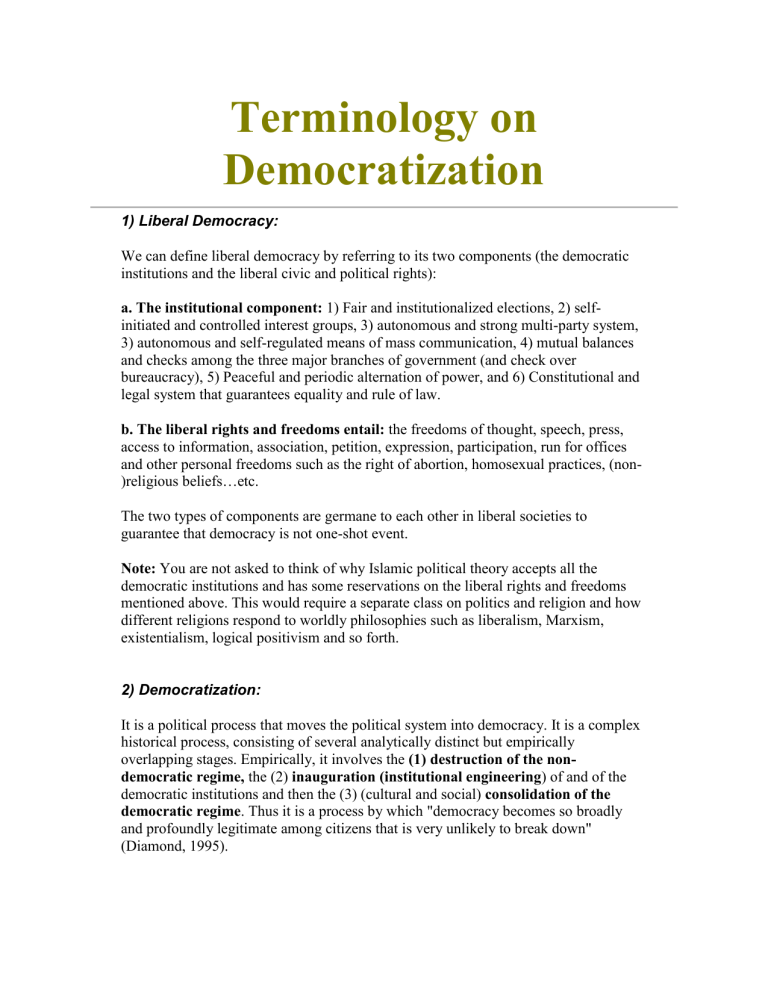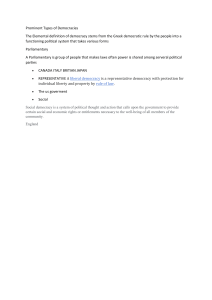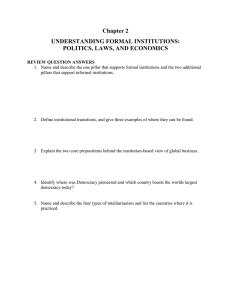
Terminology on Democratization 1) Liberal Democracy: We can define liberal democracy by referring to its two components (the democratic institutions and the liberal civic and political rights): a. The institutional component: 1) Fair and institutionalized elections, 2) selfinitiated and controlled interest groups, 3) autonomous and strong multi-party system, 3) autonomous and self-regulated means of mass communication, 4) mutual balances and checks among the three major branches of government (and check over bureaucracy), 5) Peaceful and periodic alternation of power, and 6) Constitutional and legal system that guarantees equality and rule of law. b. The liberal rights and freedoms entail: the freedoms of thought, speech, press, access to information, association, petition, expression, participation, run for offices and other personal freedoms such as the right of abortion, homosexual practices, (non)religious beliefs…etc. The two types of components are germane to each other in liberal societies to guarantee that democracy is not one-shot event. Note: You are not asked to think of why Islamic political theory accepts all the democratic institutions and has some reservations on the liberal rights and freedoms mentioned above. This would require a separate class on politics and religion and how different religions respond to worldly philosophies such as liberalism, Marxism, existentialism, logical positivism and so forth. 2) Democratization: It is a political process that moves the political system into democracy. It is a complex historical process, consisting of several analytically distinct but empirically overlapping stages. Empirically, it involves the (1) destruction of the nondemocratic regime, the (2) inauguration (institutional engineering) of and of the democratic institutions and then the (3) (cultural and social) consolidation of the democratic regime. Thus it is a process by which "democracy becomes so broadly and profoundly legitimate among citizens that is very unlikely to break down" (Diamond, 1995). Consolidation of democracy as used by Diamond differs from "deepening of democracy" as used by Robert Dahl in his book Dilemmas of Pluralist Democracy. The former is a process that takes place in countries that is transmitting toward democracy. Yet the latter is a concept that is used to refer to the expansion of the level and scope of democracy in the countries that already have political democracy. Dahl considers that there are some institutions, departments, corporations, firms, farms even families that are more democratic than others in the same society. The United State, for instance, is witnessing a process of de-deepening of democracy due to the apathy that is eroding the US social capital as Robert Putnam characterizes it in his famous article: Bowling alone. 3) Majoritarian and Consensual types of Democracies: Scholars differentiate between types of democracies according to the shape of the state (republic or monarchy), the pattern of the relationship between the legislative and executive powers (presidential, parliamentary or combination), and the concentration of authorities (federal and unitary systems). A fourth way to look at democracies is to think of the ratio of political powers (parties) that take place in the process of government. This is one of the contributions of Lijphart who develops five factors (minimal winning cabinets, executive dominance, effective number of parties, number of issue dimensions, and electoral disproportionality) to differentiate between the most consensual and most majoritarian democracies. Anderson and Guillory draw an empirical study to examine the attitudes of citizens in the minority and the majority sides toward the institutional structures of their political systems. The overarching principle that distinguishes majoritarian and consensual forms of democracy is the answer to this question: "Who rules?" The answer given by Majoritarian systems is the "majority of the people" whereas in Consensual systems it is "as many as people as possible." At the extremes, majoritarian government is about unfettered rule by the majority on the basis of an unwritten constitution without provisions for minority veto (Britain is a classic example of this type), whereas a pure form of consensus democracy is organized on the basis of a rigid, written constitution with formal veto powers for minorities. The Netherlands and Belgium typically are mentioned as prototypes of consensual model as they give the minority parties the right to participate in multi-party coalition government, balanced bicameralism, federalism and decentralization, electoral rules based on proportional representation, and written constitutions that include minority veto power and opportunities for referendums. Upon the cross-sectional survey data for eleven European democracies, Anderson ad Gullory concludes that: the losers of democratic elections show lower levels of satisfaction than do those in the majority. Moreover, losers in systems that are more consensual display higher levels of satisfaction with the way democracy works than do losers in systems with majoritarian characteristics. Conversely, winners tend to be more satisfied with democracy the more a country's political institutions approximate pure Majoritarian government. The following figure would illustrate these findings: 4) Wave of democratization: In his book The Third Wave of Democratization, Huntington identifies a wave of democratization as a group of transitions from nondemocratic to democratic regimes that occur within a specified period of time that significantly outnumber transitions in the opposite direction. 5) Partial Liberalization: It means the partial opening of an authoritarian system short of choosing governmental leaders through freely competitive elections. Summary of Huntington's Waves of Democratization First wave of democratization Second Wave of Democratization (1942-1962) Third Wave of Democratization During this long period: USA, Britain, France, Italy and Argentina became democracies. During this short period: West Germany, Italy, Japan, India, and Israel moved to democracy. Portugal, Spain, and most Asian, African East European and Latin American countries. First Reverse Wave (19221942): Italy, Germany and Argentina backed down to totalitarianism (the first two) and authoritarianism. Second Reverse Wave (1958-1975): Brazil, Argentina and Chile. 1- Huge number of democratizing countries. (1828-1926) (1974- date) 2- Mostly preconditions of democracy do not exist. 3- The future is uncertain. The Boom of Democratization: (the Political Face of Globalization). 1975 1995 Authoritarian Partial Democracy Liberal Democracy Authoritarian Partial Democracy Liberal Democracy West Europe, North America, Australia 2 0 22 0 0 24 Latin America 15 2 5 2 5 15 Asia 18 4 3 11 5 9 Sub-Saharan Africa 43 2 3 12 16 20 Middle East and Persian Gulf 14 3 2 13 3 2 East Europe and ex. USSR 9 0 0 5 14 8 68.7% 7.5% 23.8% % 1975 N= 147 26.2% % 1995 N= 164 26.2% 47.6% Source: Potter el al (editors), Democratization, 1997: 9. 6- Definition of Totalitarianism and Authoritarianism: The English language is congested with terms that are usually used to describe very similar phenomena. Terms such as tyranny, despotism, absolutism, dictatorship, monocracy, autocracy, oligarchy, authoritarianism and totalitarianism are exchangeablly used to describe non-democracies. One of the most important attempts to conceptualize these terms was made by Carl Friedrich and Zbingiew Brzezinski's in their book Totalitarian Dictatorship and Autocracy. They identified six characteristics of totalitarianism: (a) an official ideology directed to perfectionist end which is required for mobilization of masses. (b) a single mass party led by an individual, sor enmeshed in the state apparatus, (c) a technically assisted monopoly of control of weapons, (d) monopoly of the means of mass communication which is used for mass mobilization, (e) the sysapplication of terror as a means of police control, (f) and the central direction of the economy. With some modifications and additions, I am using five of these characteristics (after omitting the monopoly of control of weapons) to differentiate comparatively between authoritarian, totalitarian and democracy political systems as it is presented in the following table: Major Differences among the three major political systems 1) Ideology Totalitarianism Authoritarianism Democracy An official encompassing ideology. Not necessarily No one official ideology (pluralism) 2) Party System One mass party No parties or one party that is not mass party At least two competing parties (no frozen majority) 3) Interest Groups Corporatist Corporatist Neo-corporatism and pluralistic 4) Mass communication means: Total monopoly for mass mobilization purpose Total monopoly for apathy purposes No monopoly 5) Systematic application of terror * Very Possible against "traitors" Very possible. Less possible The do not rely totally on terror for obedience but through manipulation of beliefs (the myth of mobilization) 6) The central direction of the economy Very possible. Hitler had a guided market system. Very possible Less possible. 7) Foreign enemy Important tool for integration and energization of masses Not necessarily Not necessarily 8) Mass participation Required: German and Soviet cases: there were elections and representative institutions. To give the citizenry the sense of participation. No Not determined




